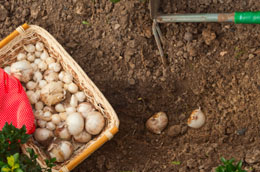Plant Allium bulbs in well drained soil to get those sprightly colored flowers that you have been yearning to have around in your garden. This article gives you exact pointers on how to plant Allium bulbs, nourish them, and care for them.

The onion genus,
Allium. has more than 600-750 species plus and still counting within its genera in the
Alliaceae family. It is a perennial bulbous plant with members like onions, shallots, scallions, leeks, garlic, chives, etc. Although it is mostly regarded as a vegetable or a herb crop, there are a few species grown for large bright colored flowers, too. This article is about these species. Native to the Northern hemisphere, mainly in Asia, ornamental flowering Alliums can be grown in most suitable regions around the world.
It is very difficult to describe this species, as each varies in height (about 5 to 150 cm), growth habits, with foliage that can either be long and narrow or slightly curled up. The only thing common is the flower. However, the flowers on each species may vary in color and stalk density. They form an umbel at the top of a leafless flowering stem known as scapes mostly shooting from the base. It is amazing to watch an inflorescence umbel flower, with the outside flowers blooming first and progressing to the inside.
Although, all alliums bear flowers, it's species and hybrids such as
Allium pulchellum,
Allium senescens,
Allium oreophilum,
Allium caeruleum,
Allium cowanii,
Allium nigrum,
Allium karataviense,
Allium unifolium,
Allium siculum,
Allium hollandicum,
Allium Firmament,
Allium Globe Master,
Allium schubertii,
Allium rosenbachianum, etc., are the ones that have a high ornamental value and can be easily found in most plant nursery stores.
Plantation
Sometimes called 'flowering onions', these can be propagated through bulbs as well as seeds, with the former being more preferable, as they take long to seed and have a higher failure rate. They look better when mass planted in flower beds, borders, and edgings than in pots. You should ideally plant the bulbs around late fall or early spring.
Prepare flower beds by digging deep in the soil. Apply bulb fertilizer or organic compost such as bone meal, peat moss, well rotted manure, etc. Make sure you choose a sunny spot or at least one that receives 4-6 hours of sunlight everyday. Plant the bulbs four inches deep in groups of 4-5 bulbs spaced about six inches apart, leaving the tip lightly covered in soil. Water adequately. Mulch heavily with dried barks if there is fear of extreme frost and snowfall. The tall varieties can be stalked as it gets heavy during a full bloom. Allium bulbs flower mid-summer through late summer and in certain conditions, even in early fall.
These bulbs do not need much feeding, a single application when the flower buds begin to appear should suffice. There aren't many pests that attack onion, the pungent smell of onion bulb mostly keeps away troublemakers. However, a few diseases like damping off, botrytis, onion smut, or downy mildew can damage the plant. But they can all be taken care of with effective and timely pesticide applications. It is recommended that the bulbs be left undistributed in the ground, and divided every 3-4 years.
Good quality allium bulbs will grow into healthy plants and flowers. For using them as cut flowers, cut no more than ¾ flower stalk. Grow them and enjoy their company.






 The onion genus, Allium. has more than 600-750 species plus and still counting within its genera in the Alliaceae family. It is a perennial bulbous plant with members like onions, shallots, scallions, leeks, garlic, chives, etc. Although it is mostly regarded as a vegetable or a herb crop, there are a few species grown for large bright colored flowers, too. This article is about these species. Native to the Northern hemisphere, mainly in Asia, ornamental flowering Alliums can be grown in most suitable regions around the world.
The onion genus, Allium. has more than 600-750 species plus and still counting within its genera in the Alliaceae family. It is a perennial bulbous plant with members like onions, shallots, scallions, leeks, garlic, chives, etc. Although it is mostly regarded as a vegetable or a herb crop, there are a few species grown for large bright colored flowers, too. This article is about these species. Native to the Northern hemisphere, mainly in Asia, ornamental flowering Alliums can be grown in most suitable regions around the world.